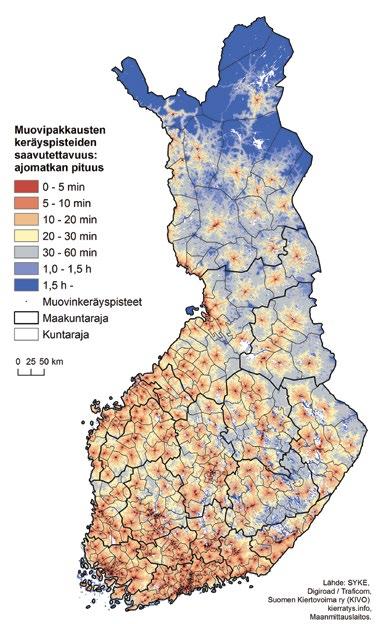ADVERTISING PUBLICATION
13
An Independent Supplement by Mediaplanet
PHOTO: GETTY IMAGES
– Up-to-date information helps goods move efficiently across transport platforms. This saves time, money and the environment, knows Anu Lahdenperä at GS1.
Other digital and logistics sub-projects of the Circwaste project: • The Central Finland Hospital District project is developing ways to make waste collection, sorting and transport more efficient at the Nova Hospital, which will open in 2021. The hospital is a pioneer in this area, as efforts have been made to minimize waste generation from the design stage onwards. Waste-specific reduction targets will be set for the hospital, and drug losses will be minimized. In addition, a monitoring system and indicators will be developed for waste management.
on store shelves, their sales time is extended, shipment volumes and times can be optimized according to consumption, and product losses can be reduced. – Now even the company that manages pallets and boxes sees in real time where the transport platforms are. In this way, they can optimize the reuse and transport of transport platforms, and if the pallet disappears, it can be traced. This is important from the viewpoint of circular economy. It has been calculated that one pallet that is leased and reused replaces proportionally nearly one hundred non–returnable pallets. In fact, 50 reusable pallets can save up to a thousand kilograms of wood compared
In the pilot of the Circwaste project, GS1 Finland developed a new feature for the Golli service that promotes the circular economy. to non–returnable pallets. – Golli’s new feature, the information flow of transport platforms, gives entrepreneurs more good reasons to use reusable transport platforms. Now even the rental time and the billing are more accurate when the information provided to the renter of the pallets is timely, Lahdenperä sums up.
Further information: Kia Paasivirta, Project Coordinator, Central Finland Health Care District, firstname.surname@ksshp.fi • In the Kangas area of the city of Jyväskylä, a district of the future will be created with functional modern waste management solutions. The purpose of innovative waste management is to encourage residents to minimize the amount of waste generated and recycle it. During the project, a method for measuring the amount of waste will be developed, as well as a billing system based on the amount of waste generated. Further information: Tanja Oksa, Project Manager, City of Jyväskylä, firstname.surname@jkl.fi
REGIONAL COOPERATION NETWORK
Together towards an efficient circular economy Text Anna Kuronen
The Circwaste project is currently ongoing in Southwest Finland, Central Finland, South Karelia and North Karelia. Each region has its own cooperation group led by ELY Centres (Centres for Economic Development, Transport and the Environment), including main stakeholders in waste management. Co-operation groups help the local administration, businesses and residents to operate resource efficiently by providing support and expertise. The aim is to increase the regional recycling rate, promote the circular economy and enable the objectives of the national waste plan to be achieved through regional road maps.
Regional road maps The regions have set their objectives in road maps and chosen the priorities by which they will contribute to the implementation of the national waste plan. For example, one of the goals in Southwest Finland is to recycle 60 percent of the biowaste contained in municipal waste, while North Karelia aims at increasing the recycling rate of all municipal waste to 60 percent. In the road map of South Karelia, one of the priorities is biodegradable and forest-based cycles, while Central Finland will focus on biodegradable waste, biogas and nutrient cycling. All actions are scheduled in the road maps. In some of the road maps, responsible parties have been designated for the measures. Progress will be monitored
through regional indicators, and road maps will be updated as the project progresses by bringing in new priorities and measures. The co-operation involves the following stakeholders: Valonia, the Regional Council of Southwest Finland, the City of Lappeenranta, the Regional Council of North Karelia and the Regional Council of Central Finland.
Pioneers have ambitious goals The pioneering network includes the municipalitie of Ii, Jyväskylä, Kuopio, Lahti, Lappeenranta, Porvoo, Riihimäki, Rovaniemi, Turku and Vantaa. These municipalities also draw up their own road maps to a circular economy, taking into account local strengths, specif-
ic characteristics and challenges. In addition to activating residents, they will start new business and build new cooperation with various actors. The common shining light for these pioneers is be among the first ones who reach the national goals. That means they will recycle at least 55 percent of their municipal waste and recover at least 70 percent of their construction and demolition waste as materials. In addition, by the end of 2020, their waste volumes will be reduced to the level of 2000.







